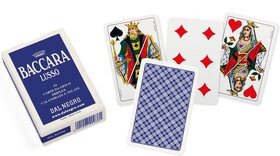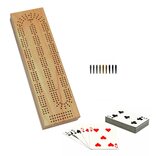The Rules of Cribbage
Most of this file describes six card cribbage, the most common two player cribbage game. For five card cribbage, seven card cribbage and four handed cribbage, please see the bottom of this document.
See also: Cribbage.
Six Card Cribbage
Scoring
Cribbage is played with an ordinary pack of 52 cards without jokers. Scoring is normally recorded on a traditionally crafted board with four parallel lines of 30 holes each plus 2 game holes. Other cribbage board types exist. Two pegs record the score for each player, the rear peg showing the previous tally, the foremost peg recording the current score. The pegs move up the outside of one side of the board and then back down the inside.
Objective
The aim of Cribbage is to be the first to move the pegs all the way up and down the board twice and end in the in the game hole. Or put another way, to be the first to score 121 points. Note that the game ends immediately either player reaches the final hole even if this is during the play or when the dealer pegs "two for his heels". There is no requirement to get exactly 121 - it is simply the first to reach the target score. Competitions are normally played as the best of 3 games, a game being to either 61 or 121. Players take turns to deal the first hand of each game.
The Deal
Players cut for the deal - lowest card wins. After the first hand, players take turns to deal. The dealer shuffles, asks his opponent to cut and then deals six cards each. Both players discard two cards face down and these two cards are henceforth referred to as "the crib" or "the box". This crib is effectively an extra hand scored for the dealer. So the dealer aims to discard cards into the crib that will give a good chance of a high scoring hand whereas the opponent aims to confound this objective. Most of the skill in the game of Cribbage is down to the choice of cards discarded at this point.
The Cut
Next the dealer asks his opponent to cut the cards another time. The top portion of cards is placed underneath the lower portion and the new top-most card is turned face upwards. If this card is a Jack, the dealer pegs two points and says "Two for his heels".
The Play
The opponent begins the Play by laying one of his four cards face up while clearly stating it's numerical value. All royal cards count ten, the ace counts one and other cards are worth their pip value. The dealer then lays a card separately in front of himself and announces the total of both cards. Play continues like this with each player alternately laying a card on the pile in front of him while verbally keeping tally of the current joint total. However, the total must not go above 31. When a player cannot play without taking the total above 31, that player says "go" and, if possible, the remaining player must carry on alone until that player, too, cannot play without taking the total above 31. When neither player can play any card without taking the total above 31, the player who laid the last card pegs 1 point saying "One for last". Should either player manage to take the total to exactly 31, that player pegs 2 points instead of 1, saying "Two for thirty-one". Then the cards already played are turned over and the player who did not lay the last card starts a new play. When one player's cards are exhausted, the other player continues alone. The last card played scores 1 "for last" (unless the amount is 31 in which case 2 points are scored). During the play, the following events are scored and the appropriate amounts are immediately recorded on the cribbage board.
- If anyone lays down a card which brings the total to 15, 2 points are scored.
- If anyone lays down a card of the same type as the previous one, 2 points are scored ("2 for a pair"). In this context, the numerical value is not used so, for instance, a Jack cannot be paired with a Queen.
- If anyone lays down a third card of the same type, 6 points are scored ("6 for a pair royal").
- If anyone lays down a fourth card of the same type, 12 points are scored "12 for a double pair royal").
- If anyone lays down a card such that with the two preceding cards, a run can be scored, 3 points are scored. The cards do not have to be of the same suit nor do they have to have been laid in sequential order. Aces count low so Queen, King, Ace is not a run.
- Similarly, if anyone lays a card such that with the three or more preceding cards, a run can be constructed, the number of cards which would make up that run are scored. e.g. suppose cards were laid in the following order: 8,6,4,5,7. The fourth card would score 3 points, the fifth card would score five points.
The Show
Each player then counts the score of the four cards in his hand plus the turned up card. The non-dealer shows first and this is important because it can often make the difference between winning and losing.
- Fifteen - All combinations of cards that add up to fifteen count 2 points.
- A pair, a pair royal or a double pair royal - count 2, 6 or 12 respectively.
- A run - A point for each card in a run.
- A flush - Four or five cards of the same suit. A point is scored for each card. A 4 point flush can only be scored using cards from the hand. The turned up card can ONLY be used in a five card flush. Note that flushes do not count in the play.
- One for his nob - a jack of the same suit as the turned up card. This is always scored last so that the score is tallied by finishing with the satisfying phrase "and one for his nob".
The Crib
Finally, the dealer counts the score of the cards in the crib plus the turned up card and adds these points to his total. Scoring is done in exactly the same way as for the show except that a crib can only score a flush if all five cards are of the same suit for five points.
Explanation of Six Card Cribbage by Example
Example of The Play
The number shows the card laid down while the text shows what would be said while laying down the card. The score for that turn is also indicated.
- 5 - "Five" - 0
- 5 - "Ten and two for a pair" - 2
- 5 - "Fifteen for two and six for a pair royal" - 8
- 6 - "Twenty one" - 0
- 4 - "Twenty five and three for a run" - 3
- 3 - "Twenty eight and four for a run" - 4
- 3 - "Thirty one for two and two for a pair" - 4
- Cards are now turned over and a new play begins
- 3 - "Three" - 0
The Show - Example 1
Turned up card - Jack Diamonds; Hand - Five Hearts, Queen Spades, Queen Hearts, King Clubs Total score 16. While totting up this hand, the player would say something like "Four fifteens for eight, two for a pair is ten and two runs for six is sixteen". It's common and perfectly acceptable for beginners to display the various combinations as they mention them; old hands normally wouldn't bother since immediately the hand is shown, the score would be known to all.
The Show - Example 2
Turned up card - Queen Diamonds; Hand - Jack Hearts, Jack Diamonds, Queen Spades, King Clubs Total score 17. While totting up this score, the player would say something akin to "Two pairs for four, four runs for twelve and one for his nob is seventeen".
The Show - Example 3
Turned up card - Three Spades
Hand - Ace Hearts, Two Hearts, Four Hearts, Five Hearts.
Total score 11. The player would say something not disimilar to "Five for a run, four for a flush and two for fifteen is eleven".
Five Card cribbage
This is a simpler game that is none-the-less preferred by many veterans. It is probably a better bet for children and beginners. It is the original form of Cribbage which has been superceded by the six-card game. The differences are:
- Play is normally once round the board - first to 61 points.
- At five card cribbage, there is a significant advantage to being first dealer. To offset this, the non-dealer pegs 3 points before the game begins. This is called "three for last".
- Five cards are dealt to each person at the start. Two cards are discarded into the crib which leaves each player with only three cards for the play and the show.
- In five card cribbage the play ends immediately that one of the players scores for 31 or "go". In six card cribbage, a new play starts once go or 31 is reached.
- In the Show, a 3 card flush can be scored but only if all three cards are from the hand. A four card flush can be scored if the turned up card is also of the same suit.
Seven card cribbage
Only experienced players play this game - it can get quite complicated. Play is to 181 points or three times around the board. Deal seven cards to each player and one to the crib. Then each player discards two into the crib so that each hand and the crib all consist of 5 cards.
Play is the same as for standard cribbage except that a flush can consist of 4, 5 or 6 cards for 1 point each card. However, you can only score a 4 or 5 card flush if all the cards in the flush are in the hand.
The highest score under seven card cribbage is 46 which can only be scored when the six cards, including the turned up card, are 6, 6, 5, 5, 4, 4. This is a total of 6 for 3 pairs, 16 for 8 fifteens and 24 for 8 runs.
Four handed cribbage
Cribbage works well as a four handed game played as partners sitting opposite one another with the North-South players against the East-West players. Players cut for the first deal. Thereafter, deal and play work in a clockwise fashion. The person ahead of the dealer cuts the cards. Five cards each are dealt and each player discards one card into the crib.
Three handed cribbage
Although it's a somewhat contrived affair, Cribbage can also be played as a three-handed game and boards with three sets of holes are available. Players cut for the first deal and, thereafter, deal and play work in a clockwise fashion. The person ahead of the dealer cuts the cards. Five cards each are dealt with a final card being dealt face down for the crib. Each player discards one card into the crib.
These rules are provided by Masters Traditional Games, an Internet shop selling quality traditional games, pub games and unusual games. For general information or for copying and copyright, see our Rules Information page.
Our rules are comprehensive instructions for friendly play. If in doubt, always abide by locally-played or house rules.
Copyright James Masters, 2025. All rights reserved.





































